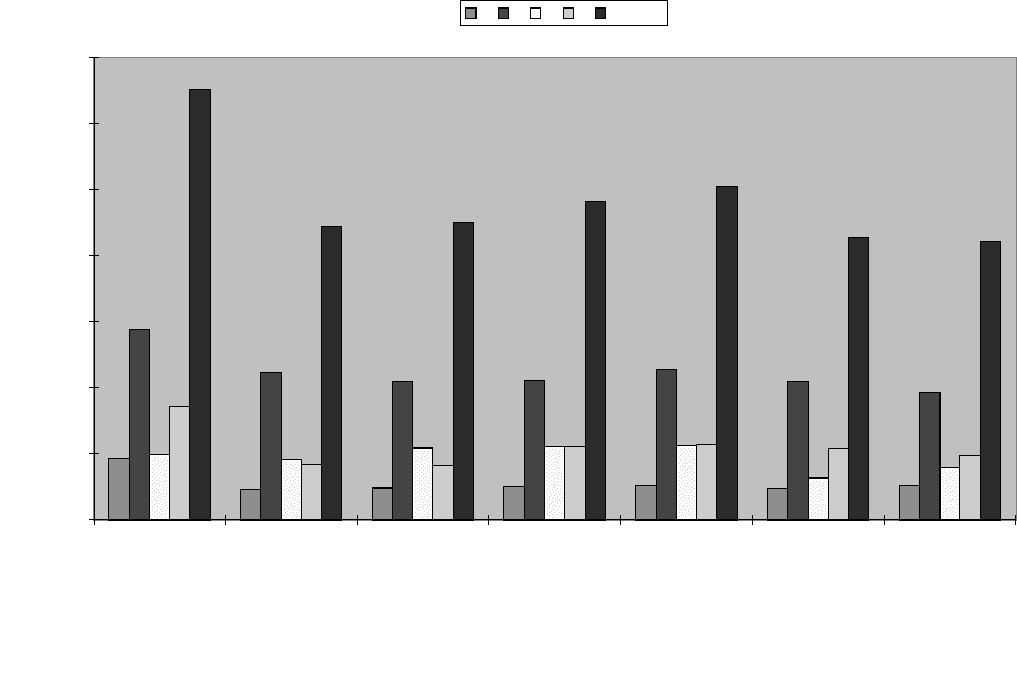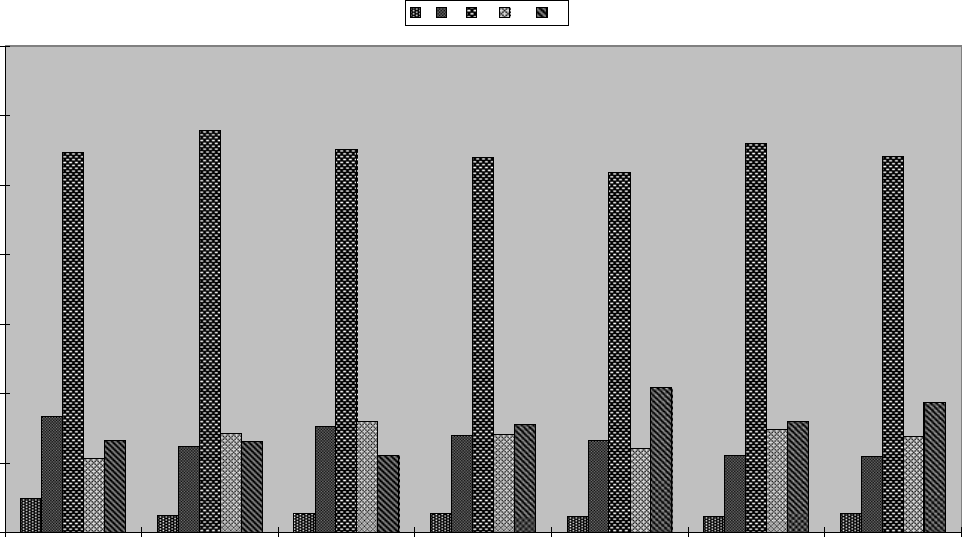Daunton M. The Cambridge Urban History of Britain, Volume 3: 1840-1950
Подождите немного. Документ загружается.


0.00
5.00
10.00
15.00
20.00
25.00
30.00
35.00
3
4
5
6 3 to 6
Greater
London
West
Midlands
West
Yorkshire
South-east
Lancashire
Merseyside Tyneside
Central
Clydeside
Figure . Percentage of private households in selected socio-economic groups, in conurbations,
⫽ higher administrative, professional and managerial (including large employers)
⫽ intermediate administrative, professional and managerial (including teachers and salaried staff)
⫽ shopkeepers and other small employers
⫽ clerical workers
Source: census for .
Cambridge Histories Online © Cambridge University Press, 2008

0.00
10.00
20.00
30.00
40.00
50.00
60.00
70.00
Greater
London
West
Midlands
West
Yorkshire
South-east
Lancashire
Merseyside Tyneside
Central
Clydeside
I
II
III
IV
V
Figure . Percentage of males in each Registrar General social class, in conurbations,
Class I⫽ professional and analogous occupations
Class II⫽ intermediate occupations (e.g. many shopkeepers)
Class III⫽ skilled occupations (including foremen and most clerks)
Class IV⫽ partly skilled occupations
Class V⫽ unskilled occupations
Source: census for .
Cambridge Histories Online © Cambridge University Press, 2008

clerical employment – evident from the late nineteenth century, and accelerat-
ing from the First World War – which (along with a corresponding decline in
the number of employers) was the most striking change in the internal occupa-
tional composition of the middle class. Thus the provincial urban middle class
was numerous and was drawn from a variety of occupations outside as well as
within industry, just as the London (and broader south-eastern) urban middle
class included many members who drew their livings from industry as well as
from commerce and dealing.
This judgement is confirmed by a variety of impressionistic information, for
the twentieth as for the nineteenth century. Thus from the s all provincial
cities – and, by the s, all substantial provincial towns – participated
significantly in middle-class suburbanisation, often initially within city boundar-
ies.
32
Also, while nothing elsewhere could rival Oxford Street’s shops, provincial
cities boasted the substantial department stores which depended to a significant
degree on middle-class customers, especially women.
33
Clearly the proportion of the population which was middle class affected the
social atmosphere of a town or city. Arguably, the social relations of towns with
relatively small middle classes might have been especially stark, featuring a ‘naked
battle between capital and labour, with the proviso that labour often genuinely
deferred to capital’.
34
Yet the existence of a middle class even of per cent of
the population of a later nineteenth-century industrial town could mean a much
more complex pattern of social relations – especially if that middle class included
a series of gradations between the very rich and those not much better-off than
the skilled working class – than in those early industrial localities where large
industrialists faced a large working population with few intermediaries.
35
The internal stratification of the middle class, therefore, shaped the lives of
middle-class urban dwellers and influenced the impact that the middle class had
on Britain’s towns and cities more generally. There were enormous differences
in resources – and in life style (see pp. – below) – between: the upper middle
class of large industrialists and other leading business and professional people; the
middle middle class of middling manufacturers, managers and substantial dealers
and professionals; and the lower middle class of white-collar employees and small
(but employing) retailers and craftsmen. In the Black Country, for example, the
middle class stretched from the Bilston steelmaster Sir Alfred Hickman (who left
£ million at his death in ) through solid professional people like the West
Bromwich surveyor Thomas Rollason (£, in ) to individuals of
modest means such as the Dudley grocer Robert Preece (£, in ).
36
The
Richard Trainor
32
See, for instance, F. M. L. Thompson, ed., The Rise of Suburbia (Leicester, ), ‘Introduction’,
p. .
33
Jackson, Middle Classes, pp. , .
34
Rubinstein, ‘English middle classes in ’, p. .
35
Cf. Trainor, Black Country Elites, pp. –, –; D. C. Howell and C. Baber, ‘Wales’, in
Thompson, ed., Cambridge Social History, , p. .
36
Somerset House, printed probate calendars.
Cambridge Histories Online © Cambridge University Press, 2008

urban, like the national, middle class was shaped like a pyramid: the lower
middle class was always by far the most numerous of the three categories; this
predominance probably increased as the numbers of white-collar employees
swelled from faster than numbers declined within the petite bourgeoisie of
small masters and dealers.
37
Yet, even with adverse changes in income tax from
, the upper middle class stayed well off – and numerous in absolute terms
– right down to .
38
Meanwhile, the situation of the lower middle class
remained perilous: even in the interwar years ordinary doctors’ bills threatened
family solvency in the household of the future historian J. F. C. Harrison, for
example.
39
Such vast differences in wealth and income contributed to feelings of super-
iority and resentment among the various strata of the middle class. Hence, for
example, the ‘ratepayers’ movements’ of the early and mid-Victorian years in
which the lower middle class (often in alliance with working-class ratepayers
who, like themselves, bore disproportionate rate burdens) often opposed the
improvements backed by the ‘solid’ middle class, that is its upper and middle
strata.
40
Likewise, even a young man from a comfortable middle-class home, the
future historian Richard Cobb, resented deeply the condescension of his better-
off cousins from Sevenoaks.
41
These contrasts in resources and attitudes among
social strata partly coincided with differences among the major occupational
groups within the urban middle class. Retailers, craftsmen and all but the top
white-collar employees were especially suspect, while there were hints of ten-
sions between industrialists, on the one hand, and professionals and the com-
mercial/financial sector, on the other.
42
Thus, with regard to occupational
groups as well as social strata, the urban middle class would appear, in F. M. L.
Thompson’s words, fragmented into ‘layer upon layer of subclasses, keenly aware
of their subtle grades of distinction’.
43
Yet, other resource-related factors bound together the three major social
strata, and the various occupational groups, of the urban middle class. All but its
lowest fringe had advantages over the majority of the population both in overall
material resources and in terms of mortality and morbidity. The great bulk of
the group also had significant stakes in the middle-class version of ‘respectabil-
ity’ and participated in the middle-class income and property cycles linked to
The middle class
37
For the survival of the latter see G. J. Crossick and H.-G. Haupt, The Petite Bourgeoisie in Europe
– (London, ), pp. , –.
38
Rubinstein, ‘Britain’s elites in the interwar period’, pp. –.
39
J. F. C. Harrison, Scholarship Boy:A Personal History of the Mid-Twentieth Century (London, ),
p. .
40
On these movements see E. P. Hennock, ‘Finance and politics in urban local government in
England, –’, HJ, (), –; Trainor, Black Country Elites, pp. –.
41
R. Cobb, Still Life: Sketches from a Tunbridge Wells Childhood (London, ), pp. –.
42
Trainor, Black Country Elites, pp. –; H. J. Perkin, The Origins of Modern English Society –
(London, ), ch. .
43
F. M. L. Thompson, The Rise of Respectable Society (London, ), p. .
Cambridge Histories Online © Cambridge University Press, 2008

stages of life.
44
In addition, few middle-class people were complacent regarding
these advantages. Rising standards of prestigious consumption strained family
budgets. Also, while economic vulnerability was most typical of the lower middle
class, fear of downward mobility affected most of the group, notably during and
immediately after nineteenth-century slumps and in the s.
45
As working-
class organisations such as trades unions and trades councils began to make a
significant impact on urban as on national life from the late nineteenth century,
resource patterns encouraged greater identification with the broader middle class
even amongst the especially marginal petite bourgeoisie. Likewise, with regard to
occupational distinctions, as the period progressed the more substantial shop-
keepers, craftsmen and white-collar workers increasingly saw themselves, and
were regarded, as members of the ‘solid’ middle class. Thus at the start of the
twentieth century a prosperous Bolton wholesale and retail ironmonger and
general dealer lived near some mill owners and socialised both with doctors and
solicitors.
46
With respect to tensions between industrialists and professionals,
these were not typical of provincial cities and towns such as Leeds, Salford or West
Bromwich, in part because there was no sense of ‘pan-professional identity’, in
part because the working lives of many urban professionals and businessmen were
closely intertwined.
47
With regard to industrialists and the commercial/financial
sector, while in London the externally orientated City elite had limited dealings
with manufacturers, in provincial cities the two sectors were tightly linked. As a
manufacturer from the Chamberlain/Kenrick clan commented, there was no
condescension to manufacturers in Birmingham.
48
Even in London, residence
and social mixing correlated more with social stratum than with occupation.
49
There remains the possibility that the pattern of social stratification within the
Richard Trainor
44
R. J. Morris, ‘The middle class and the property cycle during the Industrial Revolution’, in
T. C. Smout, ed., The Search for Wealth and Stability (London, ), pp. –; Burnett, Housing,
pp. –; V. Berridge, ‘Health and medicine’, in F. M. L. Thompson, ed., The Cambridge Social
History of Britain, –, vol. : Social Agencies and Institutions (Cambridge, ), p. .
45
J. Banks and O. Banks, Prosperity and Parenthood (London, ); Nenadic, ‘Victorian middle
classes’, passim.
46
G. Crossick, ‘Urban society and the petty bourgeoisie in nineteenth-century Britain’, in Fraser
and Sutcliffe, eds., Pursuit, pp. –; Trainor, Black Country Elites, pp. –; father of Bernard
Thornley, ESRC Qualidata Centre, University of Essex: Family Life and Work Archive,
QD/FLWE/ (hereafter cited as QD etc.).
47
J. Garrard and V. Parrott, ‘Craft, professional and middle-class identity: solicitors and gas engi-
neers, c. –’, in Kidd and Nicholls, eds., Making, pp. –; Morris, Class, Sect and Party,
p. ; Trainor, Black Country Elites, p. . For a partial exception see D. Smith, Conflict and
Compromise (London, ), pp. , . Relations may have become more difficult during the
twentieth century as the relative standing of managers rose (cf. P. Thompson, The Edwardians
(London, ), p. ; H. J. Perkin, The Rise of Professional Society: England since (London,
)).
48
Michael Hope, QD/FLWE/MUC/ C//–; Berghoff, ‘Regional variations’, p. .
49
This is implicit in the analysis of upper-class, upper-middle-class and lower-middle-class districts
of London in H. McLeod, Class and Religion in the Late Victorian City (London, ).
Cambridge Histories Online © Cambridge University Press, 2008

middle class differed radically between London and the provinces, making the
two groups almost incomparable, with implications for the ability of the provin-
cial middle class to function not only outside their regions but perhaps inside
them as well. Evidence from the size of fortunes left at death and from income
tax assessments suggests that London enjoyed disproportionate shares of top for-
tunes and incomes.
50
It seems natural that so large and long-established a metrop-
olis, which was also the capital, should contain large numbers – perhaps the
majority – of the most important members of Britain’s professional, commer-
cial and (with the shift to London of company headquarters after the First World
War) even industrial communities.
Yet possible biases in favour of London in probate and income tax material
suggest caution. Also, a study of the wealth left at death by key businessmen
throughout England and Wales suggests that neither London, nor the non-
industrial occupational groups clustered there, were especially likely to generate
wealth.
51
Likewise, analysis of a key taxation return from in terms of
amounts assessed per capita suggests that provincial cities were comparable to
London as a whole (though not to the City in isolation), albeit industrial towns,
like some county towns and ports, lagged well behind both (see Table .).
Moreover, data for the Victorian period on Birmingham, Bristol, Manchester,
the Black Country, Glasgow and other Scottish cities indicate significant
numbers both of large fortunes and of high incomes. The middle classes of these
urban places, therefore, included individuals able to deal on terms of equality
with London’s wealthy elite and with great potential for influence within their
own towns and cities.
52
Differential economic development in favour of the
South-East in the first half of the twentieth century may have increased the
advantages of the metropolis with respect to its absolute number, and propor-
tion, of the upper middle and middle middle classes.
53
But even in the depths of
the Depression of the s J. B. Priestley noted many comfortable homes,
hotels and clubs in the cities and suburbs of the North.
54
Also, the fact that in
The middle class
50
W. D. Rubinstein, ‘British millionaires, –’, Bull. IHR, (), –; Rubinstein,
‘Victorian middle classes’; Rubinstein, ‘Wealth, elites and the class structure’; Rubinstein, Elites
and the Wealthy.
51
T. Nicholas, ‘Wealthmaking in nineteenth- and early twentieth-century Britain; industry v. com-
merce and finance’, Business History, (), –. On sources see, for example, M. Jubb,
‘Income, class and the taxman: a note on the distribution of wealth in nineteenth century Britain’,
HR, (), –; M. S. Moss, ‘William Todd Lithgow: founder of a fortune’, SHR,
(), –; Trainor, Black Country Elites, pp. –, .
52
Trainor, Black Country Elites, pp. –; Berghoff, ‘Businessmen’.
53
Thus Rubinstein finds (Elites and the Wealthy, pp. –) that, while provincial counties such as
Yorkshire and Lancashire increased their total tax yields in relation to London and the Home
Counties during the mid-nineteenth century, thereafter (until the disappearance, from the inter-
war period, of regionally based tax statistics) the South-East increased its significant residual lead.
Cf. Jackson, Middle Classes, ch. , passim.
54
See, for example, J. B. Priestley, English Journey (London, ), pp. , , , .
Cambridge Histories Online © Cambridge University Press, 2008

Richard Trainor
Table . Amounts assessed to income tax, in pounds per head of population, for
selected parliamentary boroughs
City of London . Norwich .
Derby . Leeds .
Westminster . Hull .
London with City . Leicester .
Manchester . Coventry .
Edinburgh . Northampton .
Liverpool . Oxford .
Darlington . Bath .
Glasgow . Sheffield .
Cardiff. Stoke-on-Trent .
Inverness . Ipswich .
London without City . Bedford .
Newcastle-upon-Tyne . Wolverhampton .
Reading . Bolton .
Salisbury . Winchester .
Bristol . Colchester .
Lincoln . Berwick-upon-Tweed .
Wa ke field . Stockport .
Worcester . Preston .
Bradford . Cheltenham .
Nottingham . Dudley .
Birmingham . Plymouth .
Middlesbrough . Oldham .
Halifax . Salford .
Aberdeen . Walsall .
Greenock . Portsmouth .
Brighton . Wednesbury .
Southampton . Blackburn .
Chester . Port Glasgow .
Exeter . Merthyr Tydfil .
Huddersfield . South Shields .
Dundee .
London with city =Chelsea, Finsbury, Greenwich, Hackney, Lambeth, London (City),
Marylebone, Southwark, Tower Hamlets, Westminster.
Population figures are for .
Assessment is for schedule D.
Source: PP ().
Cambridge Histories Online © Cambridge University Press, 2008

London’s advantage (see Figure .) in socio-economic group – the
higher administrative, professional and managerial category – was not especially
large in comparison to the provinces suggests that major provincial urban areas
contained many members both of the upper middle class and of the middle
middle class. This impression is further confirmed by returning (in Figure .)
to the five-class data, in which the capital and other parts of the South-east had
only moderate leads in class I. Thus, while outnumbered by their south-eastern
counterparts, the better-off provincial members of the middle class formed a
substantial proportion both of the provincial middle class as a whole and of the
upper ranks of the British middle class more generally.
(iii)
What was the social environment of this socially, occupationally and geograph-
ically diverse urban middle class? During working hours, there were consider-
able differences between the activities of a substantial businessman, a professional
person, a shopkeeper and a white-collar employee. Industrialists and merchants
had considerable autonomy: in the s the father of the Glaswegian J. J. Bell,
for example, worked hard in his city-centre office but on a pattern of his own
choosing before returning to his suburban home for dinner.
55
Professionals
might be more driven by clients but also had significant control over their
working conditions and hours. By contrast, even those retailers and publicans
who employed staff were under pressure to remain at their shops for many of the
long hours during which they opened, especially prior to .
56
White-collar
workers usually had considerably less control than any of these ‘independent’
groups over either the structure or the pace of the working day. Thus the
Glasgow clerk Robert Ferguson, who entered the workforce in a printing firm
just before the First World War, had to heed the office manager, ‘a pretty tough
guy, you had to be on your toes all the time’. Similarly, clerks had to take much
more care of their appearance than did skilled workers who sometimes earned
as much or even more. Ferguson differed from his siblings in manual occupa-
tions because ‘I was very conceited . . . with dress, I had to be. I had to shave
every morning of life, before I went to work.’ He had to give up boxing because
‘If you get marked – it looks terrible the next day.’ Yet Ferguson profited from
other distinctions from manual workers. During fifty-two years of work with
The middle class
55
J. J. Bell, I Remember (Edinburgh, ), pp. –. For a general discussion of hours of work see
H. Cunningham, ‘Leisure and culture’, in F. M. L. Thompson, ed., The Cambridge Social History
of Britain, –, vol. : People and their Environment (Cambridge, ), pp. –.
56
Yet resulting strains on family life might be eased if the employer lived either ‘over the shop’ or
(in small or medium-sized towns) close enough so that, as with Arnold Bennett’s ‘Edwin
Clayhanger’ in the Potteries, it was possible to return home for meals even after a separate resi-
dence had been acquired – Clayhanger (Harmondsworth, ).
Cambridge Histories Online © Cambridge University Press, 2008

the same firm, he ‘never started before nine o’clock’ and enjoyed clean working
conditions, security and fringe benefits: ‘I’m the staff you see. And I go about
with my bowler hat on from morning ’til stopping time. My pay was . . . very
regular. Holidays were paid . . . too . . . [for ] staff . . . But [not] the workers.’
57
As white-collar workers began to constitute a larger proportion of the middle
class, Ferguson’s work experience became increasingly typical, as much in its
highly structured, often limited career pattern as in its separation from manual
workers.
58
In terms of housing, as of work, the various strata of the middle class differed
significantly; a highly varied supply of urban dwellings catered to their contrast-
ing demands.
59
In England before the typical lower-middle-class family
lived in a terrace house, while its middle-middle-class counterpart usually had a
‘semi’. Upper-middle-class families favoured detached houses.
60
The latter were
often located in the suburbs which the upper stratum had pioneered, either in
an urban enclave such as Birmingham’s Edgbaston or in a cosy area outside the
city boundary such as Glasgow’s Bearsden. There was a huge contrast between
the modest house of the famous fictional clerk ‘Mr Pooter’ with his single
servant, and the huge, well-staffed piles inhabited by the Chamberlains and
Kenricks.
61
Also, while the distances involved were smaller in provincial cities
than in London, in large towns there was considerable residential segregation
within the middle class by the late nineteenth century. Thus, ‘If London had its
Dulwich, Richmond and Edgware, the same single class exclusiveness was to be
found in Bristol’s Clifton, Cotham and Redland, Nottingham’s Wollaton, West
Richard Trainor
57
QD/FLWE/, pp. , , , –.
58
For the general pattern, which as in Ferguson’s case often persisted well into the post- period,
see D. Lockwood, The Blackcoated Worker (London, ). For the increasing limitations to the
prospects of urban clerks, see G. L. Anderson, Victorian Clerks (Manchester, ); and G. L.
Anderson, ‘The social economy of late Victorian clerks’, in G. Crossick, ed., The Lower Middle
Class in Britain, – (London, ), pp. –. On career patterns, see K. Stovel, M.
Savage and P. Bearman, ‘Ascription into achievement: models of career systems at Lloyds Bank,
–’, American Journal of Sociology, (), –; M. Savage, ‘Discipline, surveillance
and the “career”: employment on the Great Western Railway, –’, in A. McKinlay and
K. Starkey, eds., Foucault, Management and Organization Theory (London, ), pp. –. For the
complex way in which social mobility affected the urban middle class see A. Miles, Social Mobility
in Nineteenth- and Early Twentieth-Century England (Basingstoke, ).
59
M. A. Simpson and T. H. Lloyd, eds., Middle Class Housing in Britain (Newton Abbot, ),
‘Introduction’, p. .
60
Thompson, Rise of Respectable Society, p. . There were, of course, significant regional varia-
tions (M. J. Daunton, ‘Housing’, in Thompson, ed., Cambridge Social History, , p. ), not least
with regard to Scotland, where many middle-class families lived in tenement flats, some of which
were large and opulent.
61
G. Grossmith and W. Grossmith, Diary of a Nobody (Bristol, ); Cannadine, Lords and Landlords.
For the early process of suburbanisation see Thompson, Rise of Suburbia, p. ; for the significance
of servant-keeping to the nineteenth-century middle class, see L. Davidoff, ‘The family in
Britain’, in Thompson, ed., Cambridge Social History, , p. ; and Thompson, Rise of Respectable
Society, pp. –.
Cambridge Histories Online © Cambridge University Press, 2008

Bridgeford [sic] and Mapperley Park, or Manchester’s Alderley Edge and
Wilmslow.’
62
Variations in housing, then, not only ‘mirrored’ social distinctions
within the middle class but also ‘helped to define and reinforce them’.
63
None the less, aspects of urban middle-class housing also drew the strata
together, albeit in ways which differed from region to region. Throughout the
middle class, by the beginning of our period, there was a strong desire for domes-
ticity, comfort and privacy. Within the home this meant – allowing for huge
contrasts in scale and quality – elaborate decoration and furnishings. As the
American visitor Ralph Waldo Emerson noticed, ‘If [an Englishman] . . . is in
[the] middle condition, he spares no expense on his house . . . it is wainscoted,
carved, curtained, hung with pictures and filled with good furniture.’
64
Middle-
class homes also emphasised clear categorisation of rooms, isolating families from
their servants.
65
In terms of location, the middle class favoured distinct separa-
tion from working-class houses, significant distancing from their own place of
work and (money permitting) a low-density neighbourhood. Thus, aided by
transport innovations, even the lower middle class increasingly suburbanised,
especially from the s.
66
In terms of location, if not scale, of housing they
then resembled the vast majority of their middle-class betters: even in
Lancashire, Yorkshire and the Home Counties only a small minority of the
upper middle class ventured farther into the countryside than the urban fringe.
67
The residential changes which affected the urban middle class during the
period – – increased ownership, the diffusion of the ‘semi’ and acceler-
ated suburbanisation – reinforced these common features. In contrast to the
pre- tradition of middle-class renting, between the world wars ‘owner-
occupation developed as the typical middle-class tenure’, covering just over half
the group by . The proportion was especially high in those towns, largely
found in the South-East, with especially large middle-class populations.
68
As a
result, ‘much of the middle middle and some of the lower middle class’ could
become property owners.
69
Builders catered for this swollen demand particularly
through ‘semis’. Well-adapted to the modest means of the new owners, these
houses represented a ‘change of both lifestyle and status’ for families like the
The middle class
62
Burnett, Housing, p. , pp. – (quote); Thompson, Rise of Suburbia, p. . Cf. R. Dennis,
English Industrial Cities of the Nineteenth Century (Cambridge, ), chs. , and ; C. Pooley,
‘Residential differentiation in Victorian cities: a reassessment’, Transactions of the Institute of British
Geographers, new series, (), –.
63
Thompson, Rise of Respectable Society, p. .
64
R. W. Emerson, English Traits (London, ), p. , quoted by Burnett, Housing, p. .
65
Daunton, ‘Housing’, p. ; Burnett, Housing, p. ; R. G. Rodger, Housing in Urban Britain
– (Cambridge, ), p. .
66
Thompson, Rise of Suburbia, pp. , .
67
R. H. Trainor, ‘The gentrification of Victorian and Edwardian industrialists’, in A. L. Beier, D.
Cannadine and J. M. Rosenheim, eds., The First Modern Society (Cambridge, ), pp. –.
68
Daunton, ‘Housing’, p. ; M. Swenarton and S. Taylor, ‘The scale and nature of the growth of
owner-occupation in Britain between the wars’, Ec.HR, nd series, (), –; Burnett,
Housing, p. .
69
R. McKibbin, Classes and Cultures (Oxford, ), p. .
Cambridge Histories Online © Cambridge University Press, 2008
